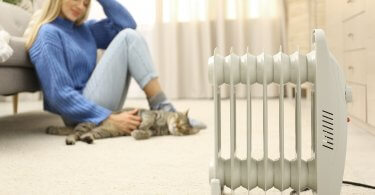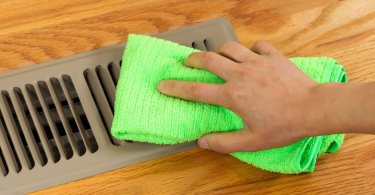You most likely may consider drying clothes on a radiator if there’s too much washing to do. Especially if it’s not feasible to dry clothes outdoors because of the weather conditions. Or if you already have your central heating switched on because it’s cold in your home.
However, you may be skeptical about its safety, which prompts you to ask yourself the question:
Is Drying Clothes On A Radiator A Good Idea?

- Is Drying Clothes On A Radiator A Good Idea?
- How To Dry Your Clothes Indoors In A Safer Way: 4 Tips
-
FAQ On Drying Clothes On A Radiator
- 1. What Is Aspergillosis?
- 2. Can Drying Clothes Indoors Increase My Energy Bills?
- 3. How Bad Can Drying Clothes On A Radiator Be?
- 4. Can Clothes Placed To Dry On A Radiator Catch Fire?
- 5. Is It Cheaper To Dry Clothes On Radiators?
- 6. Is It Safe To Put Towels On The Radiator?
- 7. How Long Does It Take To Dry Clothes On A Radiator?
- Conclusion: Is Drying Clothes On A Radiator A Good Idea?
Well, it’s no doubt an easy option to dry clothes on your radiator if it’s too cold outside. And in case your wet clothes cannot be put into a tumble dryer.
While these may seem to be valid reasons to dry clothes on a radiator, according to medical experts in Manchester, it isn’t a good idea to do so.
It is, on the contrary, a rather dangerous thing to do.
According to the experts, drying clothes on a radiator creates the perfect conditions for mold to thrive. And the problem is that this mold eventually can lead to Aspergillosis.
This is a fungal condition that not only affects the respiratory system but can spread through the body.
Breathing aspergillosis may not be very harmful to people who have healthy immune systems. And it’s a condition that is no doubt treatable with medication.
However, aspergillosis can get life-threatening in people who have:
- Weakened immune systems.
- Pre-existing lung conditions like asthma or cancer.
In this case, the fungus can cause pulmonary Aspergillosis.
This is a condition that can lead to fatal and irreparable damage to the lungs and sinuses if left unchecked.
How To Dry Your Clothes Indoors In A Safer Way: 4 Tips
However, there are ways to minimize the risk of developing aspergillosis and still dry your clothes on your radiator. In this case, keeping your home well-ventilated reduces condensation and possible mold formation.
There are various tips to consider to reduce the levels of condensation in your home. They include:
- Maintaining ventilation in the room by keeping a window ajar during the drying process.
- Installing an extractor fan to reduce the risk of mold build-up and thus also prolonging your wall life.
- Wiping down surfaces after cooking or showering if you don’t have an extractor fan. Extra moisture only turns to mold that’s not easy to get rid of.
- Make sure to properly ventilate every room in your home. Especially when your home was improved with double-glazing and insulation and when you put effort into drought-proofing it. While these improvements do help keep your home nice and cozy, they, unfortunately, reduce air ventilation and increase the amount of stale air indoors. And thus the risk of condensation.
FAQ On Drying Clothes On A Radiator
1. What Is Aspergillosis?
Aspergillosis is a group of respiratory system conditions triggered by the fungal mold, aspergillus. The severity of the disease depends on various factors.
2. Can Drying Clothes Indoors Increase My Energy Bills?
Yes, drying clothes will increase your energy bill because your boiler ends up working harder than it usually does to dry the clothes and keep the room warm. So it adds to the system’s performance and overall running costs.
The higher your energy consumption is, the higher your energy bills are. And the added moisture dispelled by the clothes can create lots of condensation and consequent damp and mold issues. If left unchecked, these mold issues can end up being expensive to eradicate.
Related article: How To Kill Mold With Temperature
3. How Bad Can Drying Clothes On A Radiator Be?
Routine drying of clothes on the radiator is not only bad for your health, but it is also bad for your property’s structural integrity. It can lead to condensation in some areas of your home, especially on walls and behind furniture.
The mold and dampness start with a few black mold marks on the wall, which soon escalates to more extensive and expensive problems. It, in turn, leads to the consequent rotting of plaster, fixings, and even walls.
The wallpaper may also eventually start blistering and peeling off. It, in turn, leads to some real damage and the added cost of a full-blown redecorating job.
You can prevent all of this by not drying clothes on the radiator too often.
Also, make it a habit to always wipe away any areas affected by mold. If required, you could also touch up the spots with some sealant.
However, if left unchecked, you end up with a case of extreme condensation and mold damage. It leads to dry rot problems, untold structural damage, and an expensive repair bill.
4. Can Clothes Placed To Dry On A Radiator Catch Fire?
Well, the radiator can slightly burn clothes made of precious fabrics like silk or satin. But usually, a radiator filled with water will not become hot enough to make the clothes on them catch fire. However, you should not use your radiators in the following ways:
- Place magazines or newspapers on them.
- Defrost gloves, scarves, and mittens upon coming in from the cold.
- Hold plates, cups, utensils, and napkins.
- Place bulky furniture near them.
Some homeowners also use radiators as an extra chair when there’s a get-together and they need an additional seat. However, this is risky as the person sitting on it will block the heat from the radiator.
The additional heat, in turn, can lead to thermal injuries from heat exposure. There is also the risk of some materials or clothes burning slightly or melting.
Related article: Can I Put The TV Near A Radiator?
5. Is It Cheaper To Dry Clothes On Radiators?
No. You end up spending more money every time you use the radiator to dry your wet clothes. Not only do you end up with increased energy bills. You also end up with potential structural damage to your walls, mold issues, and consequent repair or renovation expenses.
6. Is It Safe To Put Towels On The Radiator?
Yes, it is safe to put towels on a water radiator. If you place a towel on a convector heater or a space heater, it is an absolute No. It may cause a fire.
But, you have to remember that putting towels on the radiator insulates heat and obstructs heat circulation.
And some radiators, like convector radiators, function by creating hot currents. They thus end up working less effectively if covered by damp towels.
Related article: Does A Heater Reduce Humidity?

7. How Long Does It Take To Dry Clothes On A Radiator?
It generally takes about 2 hours to dry clothes on a radiator.
Conclusion: Is Drying Clothes On A Radiator A Good Idea?
In short, drying clothes on a radiator is a relatively safe procedure. And you do not have to worry much if you occasionally dry small pieces of clothing like socks or a damp towel on one radiator.
However, it can cause health risks if it’s an everyday affair and if you use every available radiator in your home. Mainly if you continuously cover the radiator surface to dry your clothes.
Besides, drying damp clothes on storage or convector heaters is a no-no. It can lead to a fire hazard.
So while drying clothes inside may seem a simple thing to do, it may not be a healthy option for some people.





Leave a Comment